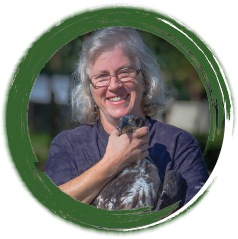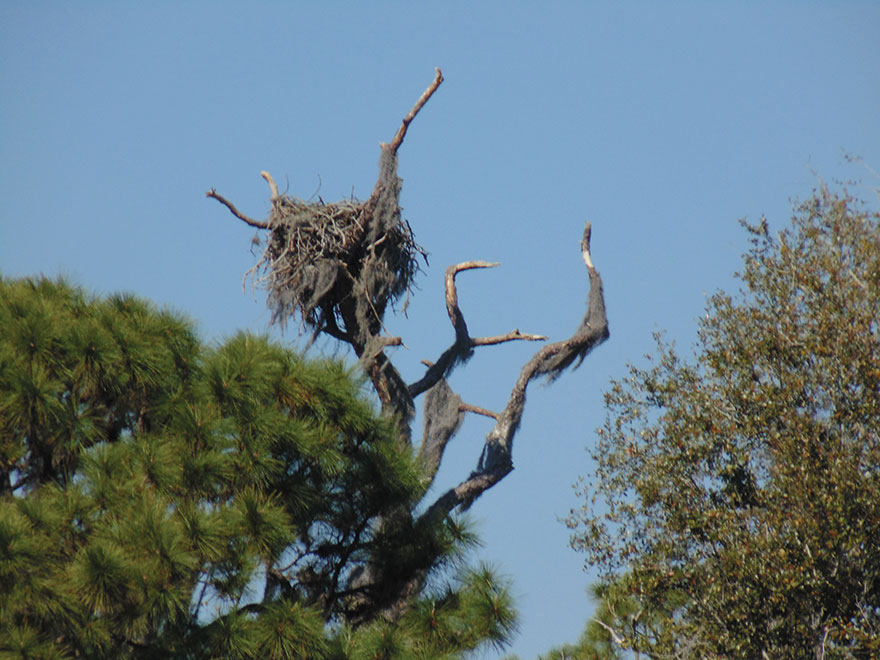Everyone likes watching birds, but some birders get extra benefits. Audubon Florida’s citizen-scientist programs create win-win opportunities for both the birds and the people who watch them.
“Anybody who loves birds wants to protect them.”
–Cheryl Merz, Audubon Florida’s Citizen Scientist Volunteer of the Year
“It’s the neatest thing in the world,” says Gabe Vargo, a retired University of South Florida professor and a longtime volunteer with Audubon’s EagleWatch. “How many people have a chance to watch these birds raise their families? They’re almost like my children.”
“Anybody who loves birds wants to protect them,” adds Cheryl Merz, Audubon Florida’s Citizen Scientist Volunteer of the Year. “We humans are the driving force that creates problems, so we need to be the force that fixes them too — one person at a time, one weekend at a time. Last year, I watched 11 nests and had 13 babies, I felt like a surrogate mother to every one of them.”
With Florida having one of the densest populations of nesting eagles in the continental U.S., volunteers who watch the nests are critically important, both to provide data to scientists on nesting success and to help save fledgling birds that leave the nest too early, notes Nancy Murrah, EagleWatch coordinator for the Tampa Audubon Society.

EagleWatch for Tampa Audubon Society.
While 80% of eagles in Florida still nest in their favored pine trees, many nests in the urbanized Tampa Bay region are perched on cell or power line towers. An eaglet that is nearly ready to fly weighs more than an adult bird – it’s as large as its parents but it’s been sitting in a nest being fed instead of foraging for its own food.
“If an eaglet falls from a nest in a tree, it can catch itself on branches before it hits the ground at full force,” she said. “That’s not the case if it falls from a man-made structure – particularly if there’s a concrete pad at the bottom of the tower.”
Having EagleWatch volunteers on the ground watching helped save the lives of five eaglets in Hillsborough County last year, Murrah said. “We had one eaglet fall and a transporter came to take it to the Audubon Center for Birds of Prey in Maitland — our volunteers had already been there for hours.”
EagleWatch volunteers are expected to watch “their” nests for at least 20 minutes two times a month to report on their activities. The goal is to have two or three volunteers per nest so that any potential problem is caught early, Murrah said. “We don’t want untrained volunteers to try to rescue an eaglet that’s fallen from its nest — they’re big birds, it could be dangerous for both the volunteer and the bird.”
The Florida Fish and Wildlife Conservation Commission has been conducting aerial surveys of eagle nests since the 1970s when DDT was banned. Today populations are at the highest numbers since eagle nests have been monitored. “In 1974, we counted less than 100 nests – last year we were close to 1500 nests,” said Michelle Vandeventer, FWC’s bald eagle coordinator.
Along with EagleWatch, Audubon coordinates ColonyWatch for colonial nesting birds, including a surprising number of nesting sites inland; JayWatch to monitor populations of scrub jays, Florida’s only endemic bird; and bird steward programs for beach-nesting birds.
“Unlike eagles, colonial birds nest in large groups,” said Ann Paul, Audubon’s Tampa Bay area regional coordinator. “It helps protect them from predators but it also means that all their eggs are in one basket.”
Along with the coastal sites — including several in the region that are listed as globally important bird areas — colonial birds often nest on inland sites, typically islands that provide protection from predators like raccoons and feral cats.
In Hillsborough County, ColonyWatch volunteers kept a close eye on 20 inland colonies and identified two new colonies this year. “One was in the trees in a Verizon parking lot but no one knew about it until a baby bird fell,” said Merz, who also serves as ColonyWatch coordinator for the Tampa Audubon Society. “There probably are other sites we don’t know about.”
Like bird stewards on the region’s beaches, one of the most important accomplishments for ColonyWatch volunteers is advocating for the birds with neighbors. “The birds are running out of room and everybody needs to do what they can to help them nest successfully,” Merz said.
“Our ColonyWatch volunteers are the first people who notice when their neighborhood birds start to nest in the Spring,” says Mark Rachal, manager of Audubon’s Florida Coastal Islands Sanctuaries. “They’ll call and let me know, and then call again if they need assistance.”
And it doesn’t require expert bird-watching skills or expensive equipment, Merz adds. “I didn’t get involved with wild birds until about five years ago – there is a learning curve, but it’s easy for anyone who wants to learn about how they can make a difference.”
Learn more:
- Attend the EagleWatch orientation at the Seffner-Mango Library, 410 N. Kingsway Road in Seffner, Oct. 3, from 11:24 a.m. to 2 p.m., reservations requested, email eaglewatch@tampaaudubon.org.
- Check out the poster presentation on Audubon’s partnership with the Port Tampa Bay at BASIS 6, Sept. 28 to 30 at the University of South Florida’s St. Petersburg Student Center.
- In Hillsborough County, Nancy Murrah, eaglewatch@tampaaudubon.org or 813-205-1851.
- In Pinellas County, Barbara Walker, barbibird@tampabay.rr.com or call 727-442-9140
- In Polk County, Reinier Munguia, rmung@wildstockphotos.com or call 863-797-7374
- In other counties, Matt Smith, Florida Audubon Eagle Watch coordinator, eaglewatch@audubon.org or 407-644-0190
- To participate in ColonyWatch, contact Ann Paul, apaul@audubon.org or 813-623-6826.
Raptor rehab facility planned for Hillsborough County

Rehab facilities for injured birds have long been an issue in the Tampa Bay region, and most injured raptors are currently transported to the Audubon Center for Birds of Prey in Maitland – a long journey which creates additional stress for the injured bird.
Murrah, along with Reinier Munguia in Polk County and Barb Walker in Pinellas, is working to identify property and funding for a rehab facility centrally located in Hillsborough County.
“We’ll need eight to 10 acres to build the flight cages the birds need to learn to fly again, and two full-time vet techs,” Murrah said. “Several local vets have been very supportive because there really is a critical need for this kind of facility on the west coast.”
Estimated cost is $3 million, and Murrah hopes to open the facility by January 2017. “We’ve already gotten enthusiastic support from everyone we talk to,” she said.
Eagle Etiquette

The Florida Fish and Wildlife Conservation Commission posts an updated lists of eagle nests throughout the state. If you visit, please follow these recommendations for responsible viewing of nesting eagles:
- Maintain a buffer of at least 330 feet from the nest and respect restricted areas, particularly privately owned lands.
- If possible, park in a safe location and remain in or immediately next to your vehicle while viewing. (Eagles don’t seem to react to automobiles as much as they do people.)
- Do not approach the nest directly or attempt to make an eagle fly.
- Avoid loud noises, such as yelling, door slamming, or horn honking.
- Use binoculars or a spotting scope instead of trying to get “a little bit closer.” If you’re using a phone to take a photo – you’re too close.
Photos courtesy Nancy Murrah
